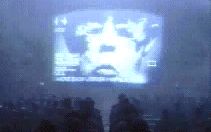|
1983
The
Domain Name System (DNS) is
designed by Paul Mockapetris of the University of Wisconsin. Whereas the
previous system required users to access addresses using an assigned IP
number, the new system (introduced to the public in 1984) directs packets
to a domain name, which are translated by a server database into the
corresponding IP number. The extensions .com, .edu, .gov, .mil,
.org, .net, and .int are designed into the naming scheme.
In addition
to the development of the DNS, 1983 marks the year that ARPAnet begins to
use TCP/IP. This is the year that the
Internet is truly born.
1984
The number
of hosts on the Internet crosses 1,000.
The
Macintosh is launched by Apple
Computer on January 24, 1984. It marks the introduction of the computer
icons and the computer
mouse to the public.
1985
The
CD-ROM (Compact Disc Read Only
Memory) is introduced into the market by Sony and Philips. The new
standard for computer discs uses the same technology as the audio CD.
The first domain name,
symbolic.com is registered on March 15, 1985.
1987
The number
of hosts on the Internet crosses 10,000.
The first
Cisco router is shipped.
1988
The
MP3 (Motion Picture Experts
Group-1, Level 3) audio compression format is created by Leonardo
Chiariglione of Germany's Fraunhofer Institut Integriete Schaltungen, and
other at the University of Erlangen.
1989
The number
of hosts on the Internet crosses
100,000.

The first
consumer CD recorder is
released by Denon. The machine, called the Denon DN-770R costs $20,000,
with blank discs costing $40 a piece.
1990
The first
writable CD is introduced by
Sony.
Digital Audio Tape (DAT) is
introduced by Sony.

The
World Wide Web is invented by
Tim Berners-Lee of CERN
in Switzerland. The innovations included
HTTP (HyperText Transfer
Protocol), HTML (Hypertext
Markup Language), and the URL
(Universal Resource Locator). In December 1990, Berners-Lee
finishes code for the first Web browser/editor,
which both creates and interprets instructions as to how to display text
and pictures in the window of the browser. Click
Tim's picture for a screen capture of the original web browser.
1991
The
MiniDisc is developed by Sony.

1992
The number
of hosts on the Internet crosses
1,000,000.
The
term "Surfing the Internet" is
coined by Jean Armour Polly
1993
The number
of hosts on the Internet crosses
2,000,000.

The
Mosaic web browser is
released. Developed by Marc Andreesen at the National Center for
Supercomputing Applications (NCSA), the Mosaic has a graphical interface,
allowing users to see pictures and graphics. Is the first popular
web browser.
The
Pentium Processor is launched
by Intel, which soon becomes the world's largest producer of
semi-conductors.
1994
The n umber
of hosts on the Internet crosses
3,000,000. umber
of hosts on the Internet crosses
3,000,000.
Netscape Communications is
founded. Netscape 1.0 is introduced to compete with NCSAs Mosaic.
1995
The number
of hosts on the Internet crosses
4,000,000.
The RealAudio player and audio
streaming technology is introduced by RealNetworks (then known as
Progressive Networks). The software is free and allows users to listen to
audio files in near real-time.
Netscape goes public on
August 9, 1995. It is the third largest ever IPO on NASDAQ by share
value.
Dial-up Internet access is
provided to consumers by CompuServe, America Online, and Prodigy.
The
development of JavaScript is
announced by Netscape.
DVD standards are agreed to by
the companies in the DVD consortium, paving the way for the eventual
replacement of the VHS format.
Quote of the Year: The Internet, of course,
is more than just a place to find pictures of people having sex with
dogs.
Time Magazine, July 3, 1995
1996
The first
browser to support JavaScript, Netscape
Navigator 2.0, is released.
The first
DVD players are sold in August in the U.S.
NEXT SECTION
GO TO:
Introduction
PART
I: The Dark Ages: When Time Stood Still
PART
II: Dawn of the Computer Age
PART
III: Dawn of the Internet
PART
IV: The Rise of (and Battle Over) the MP3
PART
V: Life After Napster
|